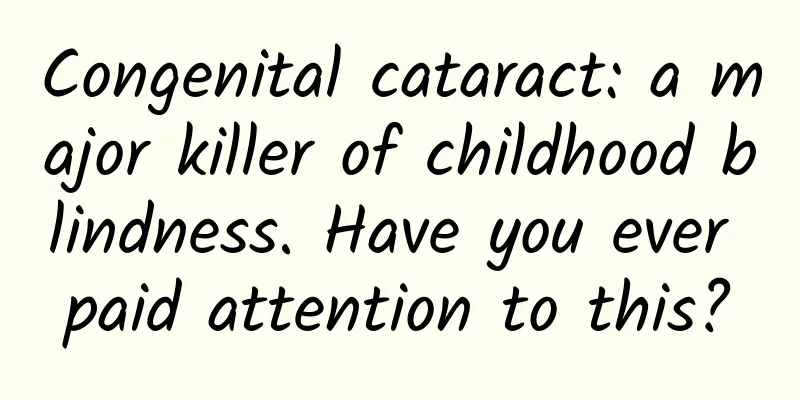Congenital cataract: a major killer of childhood blindness. Have you ever paid attention to this?

|
When it comes to cataracts, most people think that they are only for the elderly, but this is not the case. Little do people know that babies of a few months old can also get cataracts, which is congenital cataracts. Children with congenital cataracts will have a serious impact on their study and life, and may even suffer permanent and irreversible vision damage. What is "congenital cataract"? Congenital cataract refers to cataracts that exist before birth or gradually form after birth due to congenital genetic or developmental disorders. It is a common eye disease in children with an incidence rate of about 4‰, accounting for about 30% of neonatal blindness. It is an important cause of amblyopia, secondary strabismus and nystagmus in children, and ranks second among eye diseases that cause blindness in children. 01. How to detect “congenital cataract”? "Congenital cataracts" can be detected through children's eye disease screening. Some congenital cataracts have hidden symptoms, and it is difficult for parents to detect them only from the appearance of their children's eyes and their daily lives. Therefore, parents must go to regular ophthalmology medical institutions as soon as possible for children's eye disease screening. 02. Why does “congenital cataract” need early detection and treatment? The first six months after birth is a critical period for visual development. Cataracts during this period will seriously affect visual development, causing visual disability and lifelong consequences. Therefore, only early detection and early treatment can ensure the normal development of children's vision. 03. Is everything fine after the operation? Surgical treatment of congenital cataracts is only the first step in treatment. If visual function rehabilitation treatment is not followed up in time after surgery, a series of problems may occur, such as amblyopia, exotropia, nystagmus, high myopia, and visual efficiency and even higher-level visual information processing function abnormalities, which seriously affect the child's postoperative effect, learning ability and quality of life. Therefore, the treatment of children with congenital cataracts begins with surgery, but long-term functional rehabilitation is also required to ensure good postoperative results. 04. What examinations are needed after surgery for congenital cataracts in children? In response to possible problems that may arise in children after surgery, there are three main types of examinations during follow-up examinations, including eye health examinations, refractive development examinations, and visual function examinations. What is the visual rehabilitation program for children after congenital cataract surgery? 1. Refractive Correction Correcting refractive error is the basis of postoperative rehabilitation treatment for congenital cataracts. Since children who have undergone congenital cataract surgery are in the growth and development period, their needs for clear vision at near and far must be met at the same time to avoid eye health problems caused by the inability to see clearly after surgery, which affects children's academic progress and healthy growth. The refractive correction of children with congenital cataracts after surgery is different from that of ordinary children, because although they have artificial lenses implanted through surgery, their eyes do not have the ability to adjust, just like a camera without a lens cannot focus automatically, and they cannot see objects near or far clearly. Children who are in this abnormal visual experience for a long time are likely to suffer from a series of problems such as amblyopia, exotropia, nystagmus, and high myopia. Therefore, dual refractive correction of near and far objects is the first step in the patient's postoperative rehabilitation treatment. Refractive correction method after blepharoplasty A pair of glasses Linear bifocal frames for anisometropia Two pairs of glasses 1. Two pairs of single-vision glasses for near and far vision, suitable for anisometropia 2. Using contact lenses for distance vision (soft contact lenses and RGP) + single-vision frame glasses for near vision is not limited by the degree of anisometropia. RGP is particularly effective for patients with anisometropia ≥ 3D. 3. The lenses of frame glasses alone are thick, the central axis of the lens cannot always match the visual axis, and the patient lacks peripheral vision when looking at objects, which affects the visual imaging effect. RGP combined with frame glasses can reduce the magnification of retinal images, provide patients with a wider field of vision, and provide better imaging quality. 2. Visual Training Although the surgery cleared up the problem of visual information transmission in patients with cataract, the original cataract caused the visual system to develop too slowly or even stagnate, and the existing strabismus, amblyopia and binocular vision problems were not solved. If the above problems are not treated, it may cause irreversible lifelong disability. The best treatment method at present is to persist in visual training on the basis of refractive correction. "Visual training" refers to the use of optical or psychophysical methods to enable patients to better understand and control their visual abilities, thereby improving the visual function and visual comfort of the visual system, achieving the purpose of improving and repairing binocular vision abnormalities, and improving the efficiency of using related visual skills in the process of completing related tasks. Wuhan Aier Vision Training Room recommends that patients undergoing congenital cataract surgery should undergo at least 2-3 in-hospital training sessions per week and 30 minutes of home training every day. Sufficient training frequency and intensity can ensure long-term good postoperative results. Because congenital cataract patients are young and have low compliance, and have not received normal visual stimulation since childhood, the treatment time will be longer than that of ordinary amblyopic patients. The initial treatment course is 6 months, and the specific course of treatment depends on the basic visual function of the child. If nystagmus is present, the initial treatment course is 12 months. 3. Myopia prevention and control Since children with congenital cataracts have abnormal visual experience of form deprivation in their early years, they are still at high risk of form deprivation myopia after surgery, so myopia prevention and control is necessary in the follow-up observation. Children under 12 years old should be re-examined at least once every six months, and patients aged 12 to 18 years should be re-examined at least once a year. Congenital cataract patients are a special group whose visual function is in a rapid development period. Any neglect in any link may cause irreparable vision loss. In addition, most patients are young, have poor cooperation and cannot express themselves. Parents often ignore their children's eye health after surgery, which eventually leads to the child's vision stagnating or even regressing. Therefore, the degree of visual recovery after surgery often depends on the parents' attitude towards postoperative treatment. Wuhan Aier is willing to work closely with all parents to give children a bright future. |
<<: What are the benefits of eating clams? How to choose fresh clams
>>: Qingbitang Science Popularization: What are the symptoms and dangers of hypertrophic rhinitis?
Recommend
What are the early symptoms of cervical cancer?
The symptoms of cancer diseases are completely di...
Abdomen enlarged after hysterectomy
If a woman finds that her belly is enlarged after...
When will Starbucks 2020 New Year's lucky bags be released? When will Starbucks 2020 New Year's Year of the Rat series lucky bags be available?
We all know that Starbucks is a popular coffee sh...
Does the abortion unit have holidays?
There are many factors that lead to miscarriage, ...
Let me see who is still comforting themselves with "drinking tea to remove fat"
Good! Rich! Abundant! Ah! "Eat more and eat ...
How can we improve women's sexual ability?
For a couple, sex life is actually the responsibi...
The transplanted uterus will definitely not implant.
Women should pay more attention to proper health ...
What is watery leucorrhea in gynecology?
Leucorrhea is a normal vaginal discharge for wome...
What are the symptoms of moderate uterine erosion?
The uterus is an organ that every woman has, and ...
Treatment for pregnant women who sweat while sleeping
Some of us are afraid of cold in winter and heat ...
Identify the names of medicines丨Yinqiao Jiedu Pills and Lingqiao Jiedu Pills, different "passion"!
Colds and flu are common diseases. According to t...
How to apply lipstick on the inside of your lips
Lipstick is a must-have for makeup experts and is...
What to do if labia ulcers grow? How to treat
If you have ulcers on your labia, you must pay at...
How to relieve toothache during nighttime during pregnancy
Toothache during pregnancy is indeed very painful...
Will women's vagina become loose after cesarean section?
We know that after giving birth, women will exper...









